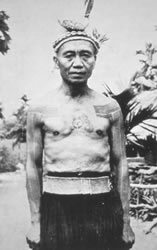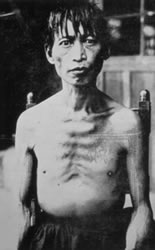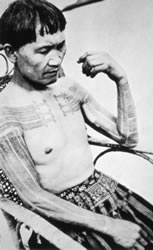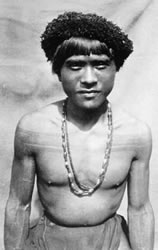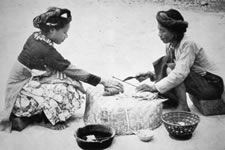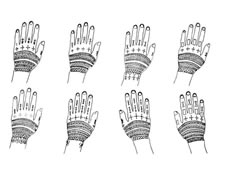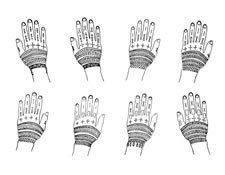Wen Shen: The Vanishing Art of Chinese Tribal Culture
Article © 2009 Lars Krutak
Tattooed Headhunters of Taiwan
As noted previously, the earliest Chinese account of tattoo on Taiwan
was written in the seventh century A.D. and appeared in the text
entitled History of the Sui (636 A.D.). Although the reference is brief,
I think there may be some truth to it since the Paiwan have a long
tradition of tattooing abstract motifs of the hundred-pace viper on
their bodies. These serpent designs adorned the skins of headhunting men
and were especially significant because they recounted mythological
origins. The hundred-pace viper is considered to be "the spirit of life,
the greatest of all the spirits" and represents the guardian spirit of
the Paiwan people.
Men and women's tattoo marks differed according to the social status
of the wearer and tattooing was generally a privilege of the Paiwan
nobility, but a commoner could purchase the right from a "big chief."
Paiwan tattooists were mostly professional women who inherited the
occupation through the family line. Each village had one or two artists,
but most were aristocrats by birth and at the same time shamans (as
opposed to male shamans amongst the Li of Hainan). Paiwan tattoo artists
received payment from all clients, except members of the ruling chief's
family. The amount of reward differed according to the complexity of the
design chosen. For example, the cost of tattooing a man's chest, back,
and both arms was high: one pig, two iron rakes, four waist knives, one
axe, one roll of cloth, one porcelain bowl, and a bottle of wine.
Paiwan tattoo artists used bamboo splints or grass stems as rulers,
and the back of a knife covered with soot as a pencil to draft the
desired motifs. Tattoo needles were made by binding a pair of steel
needles with linen thread on a bamboo stick about 40cm in length. The
needles were again wrapped with linen thread, and only 2-3cm of the
point could be seen. A small knife was used to tap the needles with soot
pigment into the skin, and the handle of this instrument was also used
to scrape away excess blood. Before the introduction of steel needles,
the Paiwan used thorns of the mountain orange as a tattoo needle.
Like other tattoo cultures in Southeast Asia, Paiwan men and women
were tattooed in the winter in the belief that the wounds would heal
more quickly in the drier air. The ritual operation was performed in a
small hut specifically built for the purpose. To prevent intruders, a
bamboo stick was erected in front of the hut. The client usually
reclined during the operation, but women who were to receive hand
tattoos sat upright. Each unit of the design was punctured
repeatedly, up to three or four times.
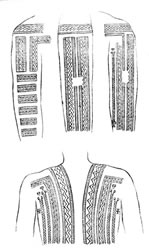 |
|
Rukai chief
and headhunter's tattoos, ca. 1900.
Among the Rukai and Paiwan, it was
believed that the spirits of their
ancestors dwelled in their beheading
knives which were held in the
possession of the tribe for several
generations.
However, the Paiwan were not
necessarily tattooed after having
taken a head. Instead, the
successful warrior was also denoted
by the wearing of a certain kind of
cap which was woven by women of the
tribe. |
Prior to the operation, the tattoo client had to present the ruling
chief with ceremonial beverages: for it was the chief who decided the
appropriate day of the tattooing. Offerings were made to the spirits of
the ancestors and various taboos were observed. During the operation,
the tattooist spat betel nut juice on the tattooed area to stop
excessive bleeding.
Paiwan women tattooed their arms, the backs of their hands, their
knees, and the calves. The designs consisted mainly of lines or dots.
Paiwan men tattooed the chest, arms, knees, and calves. Sometimes the
motifs were realistic consisting of human heads, human figures, serpent
or solar designs.
A related tribe, the Rukai, also employed female shamans as their
tattooists. Before the first marks were laid on the skin,
prayers and offerings, consisting of glass beads and betel nuts, were
given to guardian spirits in order to protect the tattoo client from
evil spirits aroused by the bloodletting. Other ceremonial taboos tied
to the tattooing included: no sexual relations immediately before the
operation; no tattooing while a corpse lay in the village or when a
woman was menstruating; no ingestion of animal blood before the
tattooing; and no use of red-colored clothing during the operation.
Next Page
|
1
|
2
|
3
|
4
|
5
|

